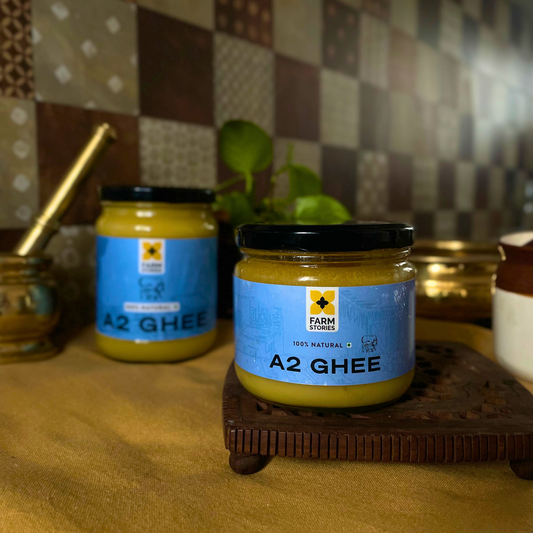
Rediscovering Ragi Atta: A Journey into the Heart of Indian Heritage and Cuisine
Share
Nestled in the rich tapestry of Indian history and cuisine lies a grain that whispers tales of resilience, nourishment, and tradition – Ragi. Often referred to as finger millet, Ragi Atta, made from finely ground ragi grains, is a forgotten gem that holds profound significance in India's cultural and culinary heritage. In this blog, let's embark on a journey to rediscover the marvel that is Ragi Atta and explore its historical roots and culinary importance.
Unearthing the Roots: Ragi in Indian History
Ragi, scientifically known as Eleusine coracana, is believed to have originated in Africa and found its way to the Indian subcontinent over 2000 years ago. With its ability to thrive in diverse climates and poor soil conditions, Ragi became a staple crop in various regions of India, particularly in the southern states and hilly terrains.
Historically, Ragi holds significance as a resilient crop that sustained communities during adverse conditions, earning it the moniker of a 'poor man's staple.' Its cultivation and consumption played a crucial role in mitigating food scarcity, making it an integral part of the agricultural heritage of India.
Nutritional Brilliance of Ragi Atta
Ragi Atta is not merely a grain; it's a powerhouse of nutrition. Let's delve into its impressive nutritional profile:
1. Rich in Calcium: Ragi surpasses many other grains in calcium content, making it an excellent choice for bone health, particularly for those who may be lactose intolerant.
2. High in Fiber: The high fiber content aids digestion and promotes a feeling of satiety, making it a valuable addition to weight management diets.
3. Packed with Amino Acids: Ragi is a rare plant source of the amino acid methionine, making it a valuable protein source, especially for vegetarians.
4. Gluten-Free Goodness: Ragi is naturally gluten-free, catering to the dietary needs of those with gluten sensitivities.
Culinary Tapestry: Ragi Atta in Indian Cuisine
In Indian kitchens, Ragi Atta weaves its way into a myriad of culinary creations, each dish telling a story of tradition and innovation:
1. Ragi Roti: A staple in southern India, Ragi Roti is a flatbread made with Ragi Atta, often enjoyed with chutney or yogurt.
2. Ragi Porridge (Malt): A wholesome breakfast option, Ragi porridge is not only nutritious but also provides sustained energy throughout the day.
3. Ragi Ladoo: A delightful sweet treat made from Ragi Atta, jaggery, and ghee, offering a guilt-free indulgence.
4. Ragi Idli and Dosa: Adding a nutritious twist to the classic South Indian breakfast favorites, Ragi Atta brings its unique flavor and health benefits.
The Modern Renaissance: Ragi Atta in Contemporary Wellness
As we witness a resurgence in the popularity of traditional and wholesome foods, Ragi Atta stands tall as a symbol of this renaissance. Its gluten-free nature and rich nutritional content align perfectly with modern wellness trends. The demand for Ragi Atta has surged not only in India but also internationally, as people recognize the value of incorporating this forgotten grain into their diets.
Ragi Atta, once relegated to the sidelines, is reclaiming its position as a nutritional powerhouse and a symbol of cultural resilience. As we embrace the significance of Ragi in Indian history and cuisine, let's celebrate its versatility in the kitchen and its potential to nourish both body and soul. Let the golden hues of Ragi Atta weave their way into your culinary tapestry, honoring a grain that has stood the test of time.
Unearthing the Roots: Ragi in Indian History
Ragi, scientifically known as Eleusine coracana, is believed to have originated in Africa and found its way to the Indian subcontinent over 2000 years ago. With its ability to thrive in diverse climates and poor soil conditions, Ragi became a staple crop in various regions of India, particularly in the southern states and hilly terrains.
Historically, Ragi holds significance as a resilient crop that sustained communities during adverse conditions, earning it the moniker of a 'poor man's staple.' Its cultivation and consumption played a crucial role in mitigating food scarcity, making it an integral part of the agricultural heritage of India.
Nutritional Brilliance of Ragi Atta
Ragi Atta is not merely a grain; it's a powerhouse of nutrition. Let's delve into its impressive nutritional profile:
1. Rich in Calcium: Ragi surpasses many other grains in calcium content, making it an excellent choice for bone health, particularly for those who may be lactose intolerant.
2. High in Fiber: The high fiber content aids digestion and promotes a feeling of satiety, making it a valuable addition to weight management diets.
3. Packed with Amino Acids: Ragi is a rare plant source of the amino acid methionine, making it a valuable protein source, especially for vegetarians.
4. Gluten-Free Goodness: Ragi is naturally gluten-free, catering to the dietary needs of those with gluten sensitivities.
Culinary Tapestry: Ragi Atta in Indian Cuisine
In Indian kitchens, Ragi Atta weaves its way into a myriad of culinary creations, each dish telling a story of tradition and innovation:
1. Ragi Roti: A staple in southern India, Ragi Roti is a flatbread made with Ragi Atta, often enjoyed with chutney or yogurt.
2. Ragi Porridge (Malt): A wholesome breakfast option, Ragi porridge is not only nutritious but also provides sustained energy throughout the day.
3. Ragi Ladoo: A delightful sweet treat made from Ragi Atta, jaggery, and ghee, offering a guilt-free indulgence.
4. Ragi Idli and Dosa: Adding a nutritious twist to the classic South Indian breakfast favorites, Ragi Atta brings its unique flavor and health benefits.
The Modern Renaissance: Ragi Atta in Contemporary Wellness
As we witness a resurgence in the popularity of traditional and wholesome foods, Ragi Atta stands tall as a symbol of this renaissance. Its gluten-free nature and rich nutritional content align perfectly with modern wellness trends. The demand for Ragi Atta has surged not only in India but also internationally, as people recognize the value of incorporating this forgotten grain into their diets.
Ragi Atta, once relegated to the sidelines, is reclaiming its position as a nutritional powerhouse and a symbol of cultural resilience. As we embrace the significance of Ragi in Indian history and cuisine, let's celebrate its versatility in the kitchen and its potential to nourish both body and soul. Let the golden hues of Ragi Atta weave their way into your culinary tapestry, honoring a grain that has stood the test of time.




